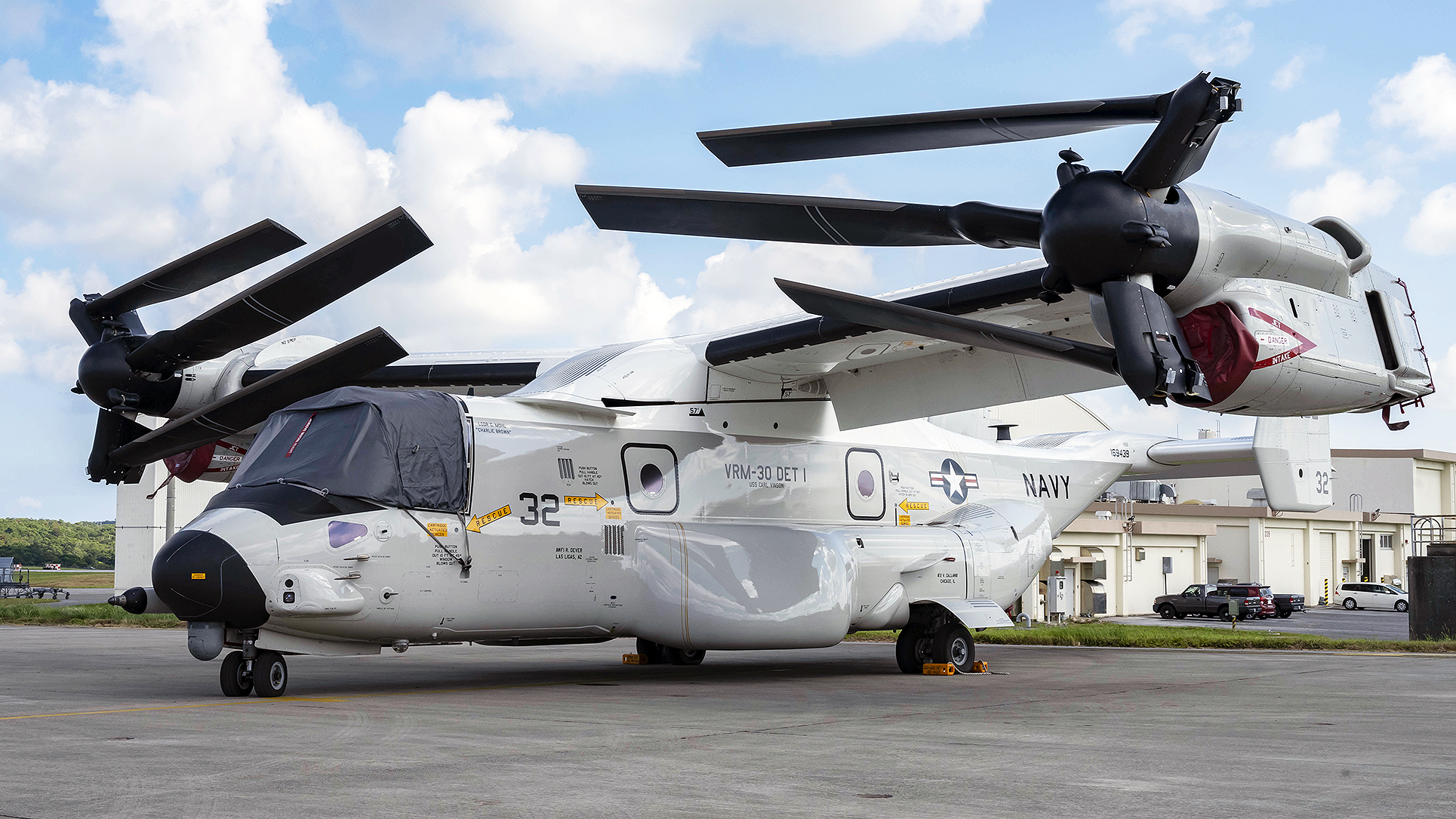A powerful Congressional subcommittee says the Navy’s troubled CMV-22B Osprey tilt-rotor aircraft are unable to perform their main function of aircraft carrier onboard delivery (COD) and wants to know what is being done to fix the problem.
“The committee understands that current CMV-22 operations are limited to flights and missions that stay within 30 minutes of a suitable divert airfield,” the House Armed Services Committee Seapower and Projection Forces subcommittee wrote in its Fiscal Year 2025 National Defense Authorization Act (NDAA) initial markup. “This prohibits the use of the CMV-22 for carrier onboard support of deployed aircraft carriers once they have left their homeport.”
That presents a potentially huge problem because the Ospreys are intended to provide a stream of vital supplies and personnel to aircraft carriers and their escorts. This logistics link has to exist even over longer distances during so called ‘blue water’ operations, where ship’s own tactical jets have no divert fields within range. As it sits now, the carriers can only be supported by the CMV-22 within close proximity to shore, which drastically negates their intended utility. In other words, the CMV-22s are basically operating within the range of what a laden heavy lift helicopter could achieve at this time.

The Carl Vinson Carrier Strike Group deployed with a detachment of CMV-22 Ospreys, “but is currently supported by the forward-deployed Carrier Air Wing 5 C-2 Greyhounds,” CDR Beth Teach, a Navy spokesperson, told us in January. “Their operational schedule was not impacted at the time, and remains unchanged demonstrating the resilience, adaptability and endurance of the Carrier Strike Group. Within the strike group and the U.S. Navy, we operate with multiple logistic redundancies across all operational envelopes, making us adaptable and steadfast.”

Meanwhile, the Theodore Roosevelt and Dwight David Eisenhower carrier strike groups deployed with C-2A Greyhounds, not Ospreys, for COD operations, Teach told us. The Roosevelt was initially scheduled to depart with Ospreys, but after a standdown following a fatal crash in Japan last year, it deployed with Greyhounds instead. The Eisenhower’s air wing was not scheduled to make the transition to Ospreys – a multi-year process – before it deployed.
That was another concern voiced by the subcommittee.
The Navy is “now relying on the aging C-2A, which was the primary aircraft for carrier onboard logistics that the CMV-22 was in the process of replacing,” the subcommittee stated. “With no other option available, the committee supports this interim solution but recognizes it is not a viable long-term solution beyond 2026.”
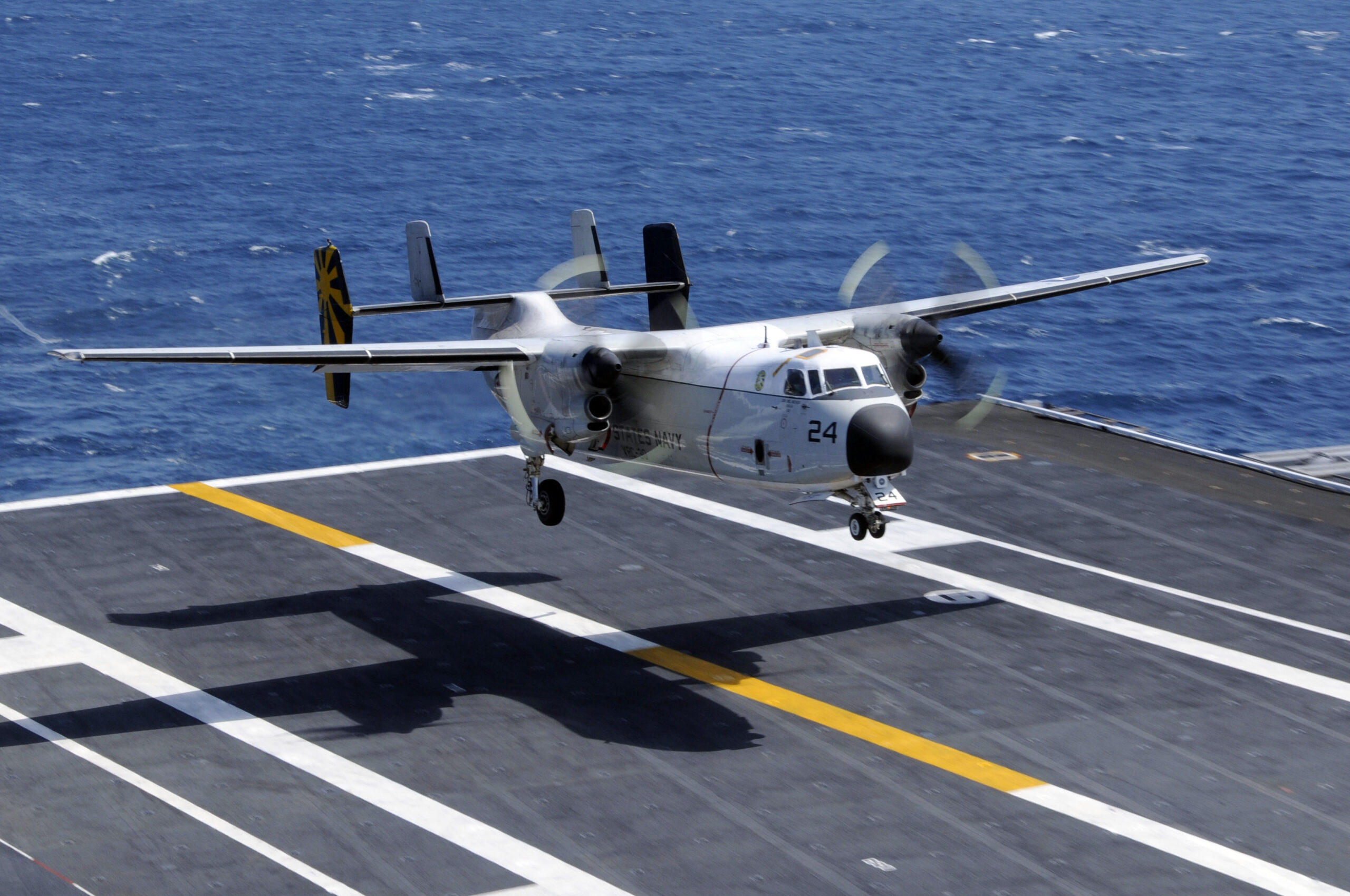
The Navy plans to stop flying the Grumman C-2 Greyhound, a twin-turboprop carrier-capable transport that first entered the service in the mid-1960s, by August 2026, a Navy official told The War Zone earlier this year. You can read more about what it is like to fly the earlier C-2 model in our interview with a former pilot here.
As a result of these issues, the committee “directs the Secretary of the Navy to submit a report to the House Committee on Armed Services by February 1, 2025,” seeking the following information:
- The long-term plan for how the Navy will support the carrier strike group beyond the date in which the C-2A platform is no longer available based on its current divestment plan;
- Options for carrier onboard delivery capability should the CMV-22 be deemed unsuitable for such missions;
- A detailed description of the carrier onboard concept of operations during combat operations in a denied environment;
- The plan to support the [Peculiar Support Equipment] PSE needs of the CMV-22 if the Navy’s unique fleet essential aircraft are not available due to operational availability or lack of sufficient numbers.
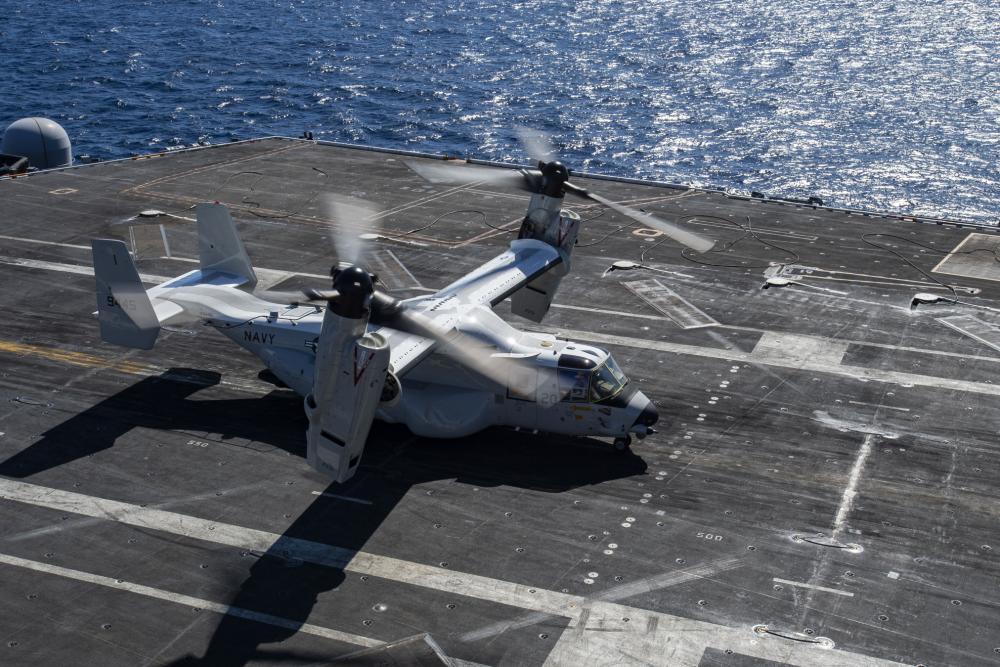
We reached out to the Air Force and Marines for comment in regard to if their aircraft are similarly operationally limited and will update this story with any pertinent details provided.
Despite its concerns, the subcommittee supports “the capability the V-22 Osprey brings across the Department of Defense with its speed and range capabilities combined with vertical takeoff and landing flexibility.” However, it wants to know more about how the Pentagon plans to improve the Ospreys across the services.
“The committee directs the Chief of Naval Operations, in coordination with the Chief of Staff of the Air Force and the Commandant of the Marine Corps, to provide a briefing to the House Committee on Armed Services not later than January 31, 2025, on the investment plan for each variant of the V-22 Osprey aircraft to ensure operational suitability,” the subcommittee additionally demanded.
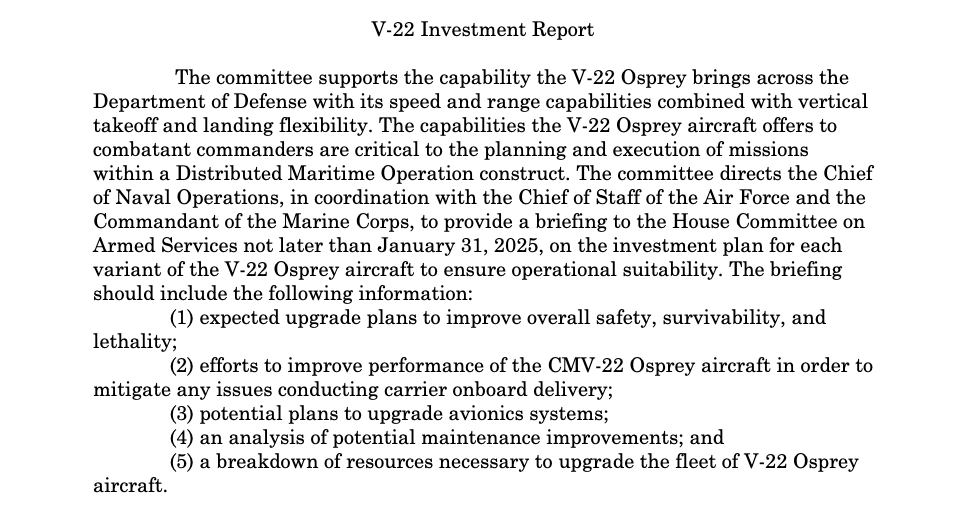
The subcommittee’s quest for answers about the V-22 program comes amid heightened concerns about the controversial Osprey.
Two months ago, V-22s across the U.S. Marine Corps, Air Force, and Navy were finally cleared for flying operations. A months-long pause went into effect in the wake of a fatal crash off the coast of Japan led to all of the aircraft being grounded.
U.S. military officials have said a “materiel failure” led to that crash, but have not yet been able to determine why that component failed. While the exact parts that failed are unknown, based on statements that have been provided so far, they are elements of the proprotor gearboxes on the aircraft. This is a part of the Osprey’s design that has proven to be problematic in various ways over the years.

“We have high confidence that we understand what component failed and how it failed. …what we’re still working on is the why,” Marine Corps Colonel Brian Taylor, the V-22 JPO program manager at NAVAIR, said at a media roundtable that The War Zone and other outlets attended in March. “We understand, generally, the mechanics of what played out.”
However, “this is the first time that we’ve seen this particular component fail in this way” and described what is currently known to have happened in the November crash as “unprecedented,” Taylor explained.
Though the Ospreys were cleared to fly, it will take the services time to restore operations fully and even then some restrictions will be in place.
Air Force Special Operations Command (AFSOC), which operates the CV-22 variant, “is executing the deliberate return to flight process,” Lt. Col. Becky Heyse, an AFSOC spokesperson, told The War Zone last month.

“This process includes simulator training for our CV-22 aircrew, maintenance inspections of our CV-22 aircraft, and a review of each aircraft’s maintenance records as prescribed by the Joint Program Office. As each aircraft is cleared, our aircrew will immediately commence flight operations. As of today, several aircraft have conducted functional check flights, the first step in resuming flying operations.“
The Accident Investigation Board investigation “remains ongoing,” Heyse added.

The Marines, meanwhile, have “confidence in the Osprey and we are laser-focused on the safety and mission readiness of our pilots and aircrew,” U.S. Marine Corps Lt. Gen. Bradford J. Gering, deputy commandant for Marine Corps Aviation, said in a statement in March when the aircraft were cleared to fly. “We have worked extensively on plans and timelines that support a deliberate, methodical, and safe return to flight. We are flying the Osprey again because our airworthiness authority cleared it for flight, because we trust our well-established operational risk management procedures, and most of all because we trust our professional pilots, aircrew and maintainers to safely get this combat-proven aircraft back into the fight.”

Plans for the Navy variant remain unclear and we have reached out to find more answers.
There have been other concerns raised about the Osprey this year. The Pentagon’s Office of the Director of Operational Test and Evaluation, or DOT&E reported that the Navy’s CVM-22Bs were “not operationally suitable due to failures of many subsystems, with the ice protection system accounting for 44% of the total operational mission failures,” DOT&E stated in its Fiscal Year 2023 annual report. You can read more about those findings in our initial story here.
Before the fatal crash in Japan, the Osprey was involved in numerous high-profile mishaps, though it is unknown at this point whether any of its previous problems involved the other subsystems DOT&E said failed.
The Air Force, as well as the Navy and the Marines, grounded some of their Ospreys in February 2023 over concerns with the aircraft’s hard clutch.

As we reported at the time, that came after the Air Force previously grounded its fleet in August 2022 after one of the aircraft made an emergency landing in Norway. Fortunately, there were no injuries as a result of that mishap, which was traced to an issue with a hard clutch on the Osprey.
Ospreys, as we noted in an earlier story, “have suffered a number of serious accidents, some of which have been fatal and some that have been linked to other materiel issues, since the aircraft first flew in 1989. There have been three fatal Marine MV-22B crashes just since March 2022. The March 2022 crash was subsequently determined to have been caused by pilot error, while a crash that followed in June of 2022 was attributed to the hard clutch problem. The most recent Marine Osprey mishap, which occurred in Australia in August 2023 remains under investigation. There have been numerous other fatal Osprey mishaps over the years.”
If the subcommittee’s assessment of the unavailability of CMV-22s to perform COD missions is accurate, that represents a large blow to the Navy’s plans to replace an aging airframe as well as expand the tilt-rotor aircraft’s mission sets.
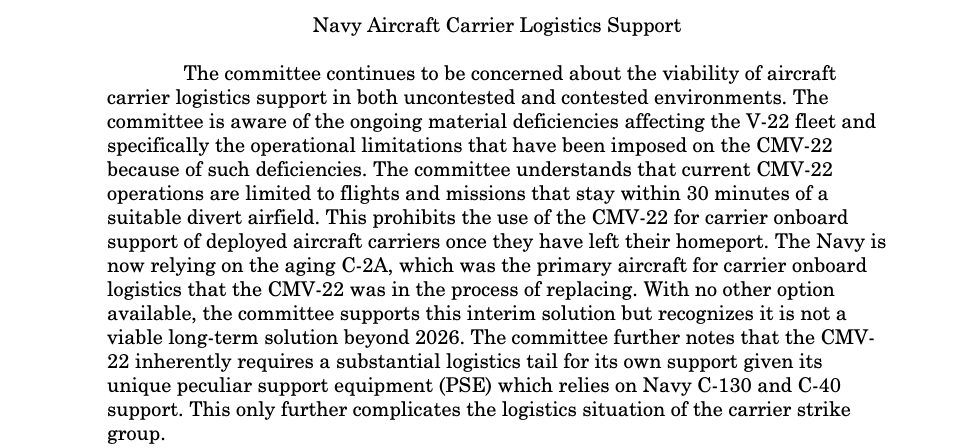
The CMV-22B’s first deployment, aboard the aircraft carrier USS Carl Vinson, was hailed as a success for what it brought to the table for transport services.
Its first deployment took place in the summer of 2021 when Fleet Logistics Multi-Mission Squadron (VRM) 30 embarked on the Vinson alongside the F-35C Lightning II and E-2D Advanced Hawkeye squadrons.
“The first deployed detachment has executed a mission completion rate of 98% and a mission capable rate of 75%,” the Navy said in a release at the time. “The CMV-22B is a crucial element of future carrier air wings due to the cargo capacity needed to transport F-35 power modules and additional logistics support for future carrier air wing deployments with next-generation platforms.”
“With distributed maritime ops, longer ranges, distances between multi-carrier operations, distances from land-based areas, and the ability for the CMV-22B to plop down on unimproved spaces, it proved to be a game-changer for us on deployment,” Vice Adm. Kenneth Whitesell, then-commander of Naval Air Forces and Naval Air Force, U.S. Pacific Fleet, said during a July 2022 Maritime Security Dialogue event hosted by the Center for Strategic & International Studies and the U.S. Naval Institute.

In April 2023, Whitesell said the CVM-22B could be used for more than COD missions.
“If you look at the CMV-22 is designed with the actual bladders and fuel capability, the weight capability to travel stuff around, because it’s meant to be able to support us in the Western Pacific.”
As we previously reported, “the CMV-22’s ability to go where the C-2 cannot — specifically to other ships in the Carrier Strike Group and austere bases ashore — is among its biggest advantages. This allows for a more flexible concept of cargo delivery operations, with the CMV-22 being able to deliver its cargo directly to other vessels and small bases ashore. It could also take on other, non-traditional roles.”
“If [an] E-2D is not available, where can [a] CMV-22 be used as a communications [node]?” Whitesell offered as one additional role that’s being looked into now. The Grumman E-2D, which is a close cousin, in terms of design, of the C-2, serves as an airborne early warning and control platform but also provides critical advanced networking and data fusion for a carrier strike group and its aircraft.
How soon the Navy can return its Osprey fleet to full capability remains unknown at the time. Despite assurances that the aging Greyhounds can fill in the gaps, how long and how well is another unknown factor that we will continue to monitor.
Update: 10:42 AM Wednesday –
Neil Lobeda, a spokesman for the Naval Air Warfare Center Aircraft Division, provided some statements to The War Zone about the limitation on the Navy’s Osprey as pointed out by Congress:
“Due to Operational Security (OPSEC), PMA-275, the V-22 Joint Program Office (PJO), is not authorized to publicly release any specifics [about] operational limitations implemented on the CMV-22s.”
On whether there have been any recent changes to the deployment of CMV-22Bs while underway and are the C-2s taking up the slack:
“The CMV-22B is the U.S. Navy variant of the V-22 and is the replacement for the C-2A Greyhound for Carrier Onboard Delivery (COD) and the Joint Force Maritime Component Commander (JFMCC) time-critical logistics air connector requirements by transporting personnel, mail, and cargo from advance bases to the Seabase. The Navy operates with multiple logistic redundancies across all operational envelopes, making us adaptable and steadfast to ensure the Navy maintain a high level of readiness. The Navy will continue to use C-2A Greyhound Carrier On-board Deliver (COD) aircraft to mitigate potential operational impacts to the carrier replenishment mission.”
On the information requested by the subcommittee:
“The V-22 Joint Program Office (JPO) understands that the House Armed Services Committee has requested the above information. While the V-22 JPO has not been formally tasked by the Office of the Secretary of Defense (OSD) in regards to this particular request; we are appreciative of the support from the committee and Congress over the life of this program and look forward to the opportunity to partner with Congress in assessing the Capability, Availability, Affordability, and Safety of the V-22 Osprey. Once we are formally provided with direction from OSD in regard to this request, we will make every effort to provide all information requested according to applicable laws and regulations. We remain confident in the V-22 Osprey and its transformative capability as the world’s only operational Tiltrotor Aircraft.”
Update: 5:21 PM May 16 –
The Marine Corps today responded to our question about whether its Ospreys have any limitations similar to those for the Navy’s variants:
“Operational security associated with our forward deployed Marines and Sailors limits our ability to provide details regarding any potential platform restrictions. However, the Marine Corps returned its MV-22s to flight on March 8, following Naval Air Systems Command’s (NAVAIR) announcement that deemed the aircraft safe to fly. Squadrons returned to flight operations through the implementation of a safe, deliberate, and methodical approach. The Marine Corps, after a thorough review of all available engineering data and with revisions to the flight manual in place, is now enacting a deliberate plan to return all 17 MV-22 squadrons to full capability. The Marine Corps’ three-phased approach begins with a focus on regaining basic flight currency, rebuilding units’ instructor cadres, and achieving proficiency in Core and Basic skill training for pilots and aircrew. Squadrons will follow well-established training and readiness manuals to gain proficiency in basic and advanced mission sets, demonstrating their ability to conduct the core missions of an MV-22 Squadron.”
Contact the author: howard@thewarzone.com
